Introduction
The hybrid working model is a location-flexible arrangement, allowing employees to combine onsite and offsite work as they and their employers see fit. Following the lifting of COVID lockdowns worldwide, a wide range of hybrid arrangements have emerged, granting employees flexibility that was seldom offered before.
Many large corporations around the world have announced that they will allow more workers to continue working from home post-pandemic, including Microsoft, Google, Facebook, and Twitter. As we all reimagine the future of work, the benefits of remote and hybrid work for employees and employers are becoming clear.
We set out to understand the value of hybrid work, and its impact on employees’ general feelings towards their places of work, productivity, and wellbeing during the pandemic. To do this, we surveyed 1,000 UK-based full-time employees aged 18+ across all industries who had continued working full-time throughout the first COVID lockdown. This survey followed a study we conducted in the US which explored attitudes and opinions about remote work and productivity.
Our goal was to understand the value of hybrid work for employees and employers. We asked employees to tell us about their feelings about HR, changes in their productivity, and any impact on their mental health and wellbeing. Let’s break down the survey results.
Who’s working from home?
Of the thousand survey respondents, 21% were working exclusively from home, 42% were working according to a hybrid framework, and 37% were working onsite.
A total of 63% of employees working full-time were working from home at least part of the time, which shows that there has been a significant change in the world of work compared to how people worked before the pandemic.
Since the beginning of the COVID pandemic, UK employers have begun offering their employees many different kinds of work arrangements. For those embracing hybrid working, several different models exist that support local social distancing and COVID standards, while also providing a flexible working environment.
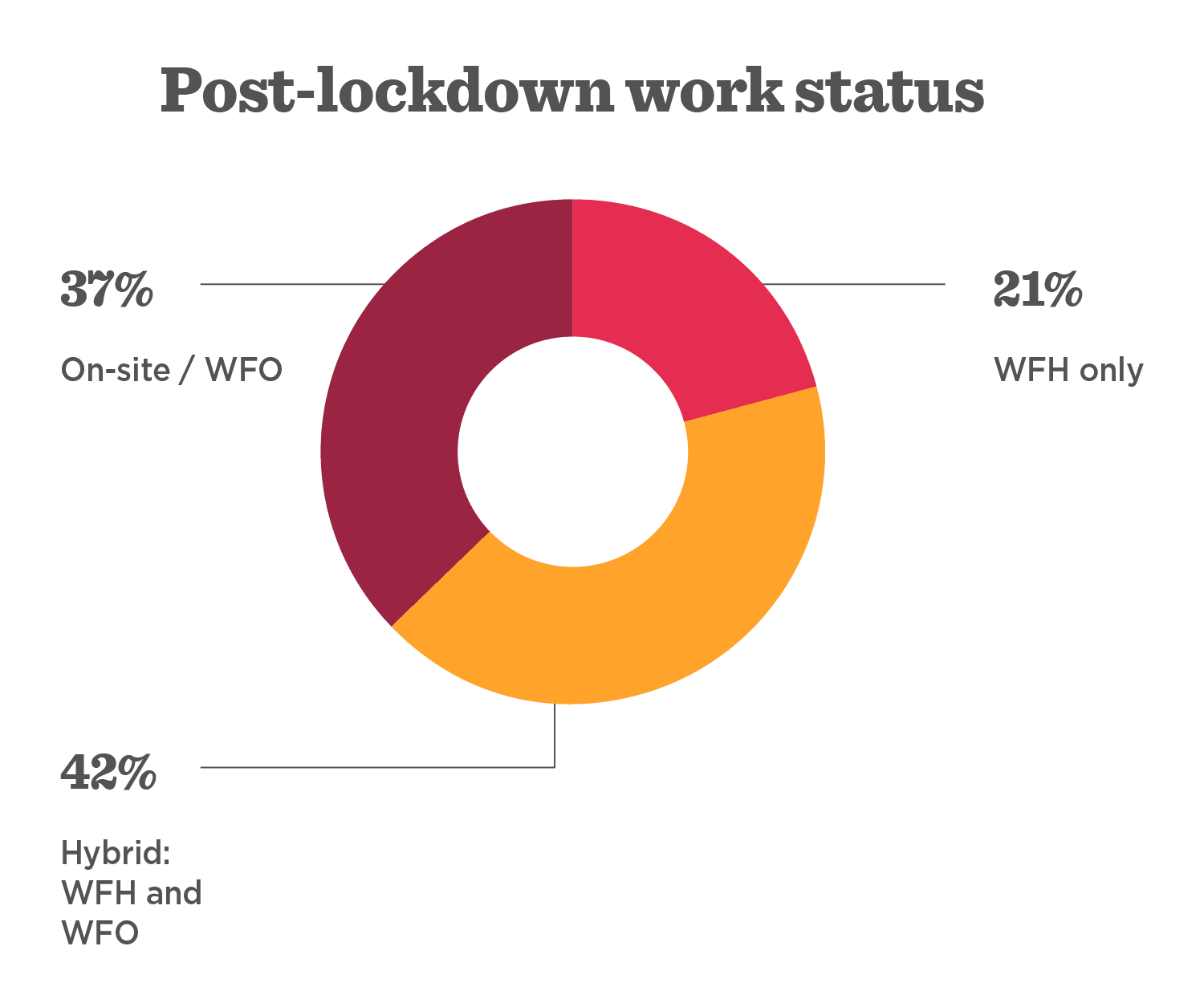
What are the different types of hybrid work models?
We found four different hybrid models being offered to employees: at-will, split weeks, shift work, and week-by-week

1. The at-will model
This model enables employees to choose the work arrangement that works best for them on any given day. It’s particularly useful for those who want to come into the office when they need to meet someone or require a quiet place to work for the day. Several companies have set up a process of placing a request to “work at the office (WFO)” to ensure that social distancing requirements are met.
2. The split-week model
The second model splits the week between working from home two to three days a week and working onsite two to three days a week. This model was seen among the highest proportion of employees. Companies using this model generally split up the week between different departments; for example, the marketing team comes into the office on Mondays and Wednesdays, while customer support comes into the office on Tuesdays and Thursdays. This hybrid model enables managers to stay in touch with their teams and allows for face-to-face group meetings on a regular cadence.
3. Shift work
In the third model, employees work in shifts, alternating between working from home and working morning or evening shifts on site. This is a more difficult model to work with because many people don’t like shift work and find it hard to get in very early in the morning or to work late at night. A hybrid model based on shift work often requires employees to set up additional childcare solutions to the ones they already have.
Recommended For Further Reading
4. Week-by-week
Finally, the fourth model sees employees alternating between working from home and working onsite on a weekly basis. This alternative is used to allow large teams to use office space together at the same time and meet up for reviews, deadlines, and updates.
The different types of hybrid work models being offered to employees often differ according to industry or role.

Expectations of HR teams regarding hybrid arrangements
Since the pandemic began, HR has taken the central stage within companies in developing a safe, productive workplace for employees and creating policies regarding how employees can continue to work, whether WFH, hybrid, or onsite. HR teams became responsible for finding solutions for overcoming social distancing requirements, adhering to local hygiene and safety requirements, and communicating changes and policies to employees quickly and efficiently.
According to our survey results, employees working hybrid tend to feel that their HR teams have adapted better to the pandemic’s effects on their companies. They feel more supported than both employees who are working at home and onsite exclusively. Of all the hybrid employees, those working at home who could work at the office “at-will”, felt the most supported by their HR team.
HiBob’s conclusion: employees who are trusted to come into work based on their judgment (at-will) appreciate the flexibility it affords them to do their jobs well and to navigate through these complex times.
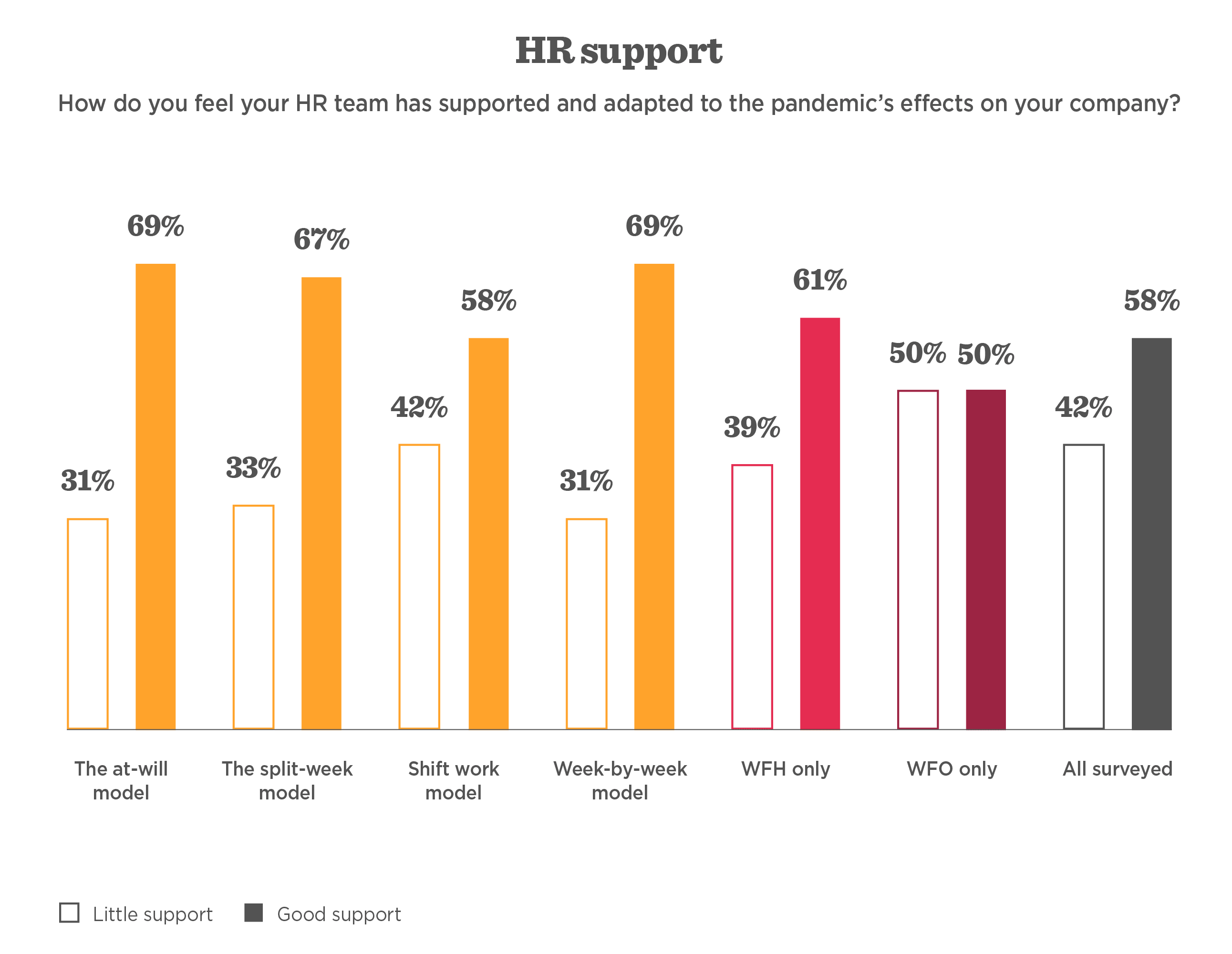
Similarly, when asked about confidence in their HR’s ability to address COVID-related remote work concerns, hybrid workers were more confident overall with their HR’s ability to handle remote work concerns. Employees able to come into the office at-will show the highest level of confidence in their HR teams; conversely, employees that were working onsite exclusively felt the least confident towards their HR team.
HiBob’s conclusion: employees working onsite full-time are less likely to trust their HR leadership because, regardless of the dangers inherent to working onsite during a pandemic, they’re forced to work onsite as usual.

Working hybrid increases productivity
Whether your people are writing code, on a call solving a customer’s inquiry, or trying to conduct a team meeting, their time is valuable and they (usually) want to perform well. Some feel more productive when working from home, while others feel more productive when working onsite. Productivity at home can be affected by a wide range of factors, such as available workspace and whether there are children or other distractions that hinder their ability to get work done.
Over the past few months, employees have had to adjust to a new reality; working from home even if they had never done so before, homeschooling their children when schools were under lockdown, and working side-by-side with significant others and roommates while being on video calls. This has been a period of change, stress, and uncertainty.
When asked about their general productivity while working from home, we found that 48% of employees felt productive when working from home, while 52% did not feel the same.
We found an interesting uplift in feelings of productivity among those employees working from home who were able to go into the office at-will—the most flexible of all of the work arrangements.
These employees choose to work onsite perhaps for a change of scenery, to collaborate with their team face-to-face, or to avoid situations that aren’t conducive to deep work (think: daytime construction). This at-will hybrid arrangement has helped them to be productive.
Like employees that were able to work hybrid, employees working exclusively from home also reported high levels of productivity, with 66% reporting being productive or very productive.
Focusing on the employees working onsite only, the data shows that 68% of them did not feel productive working from home during the period that they were forced to. This may be due to the nature of their work, and which is why, following lockdown, they returned to working onsite.
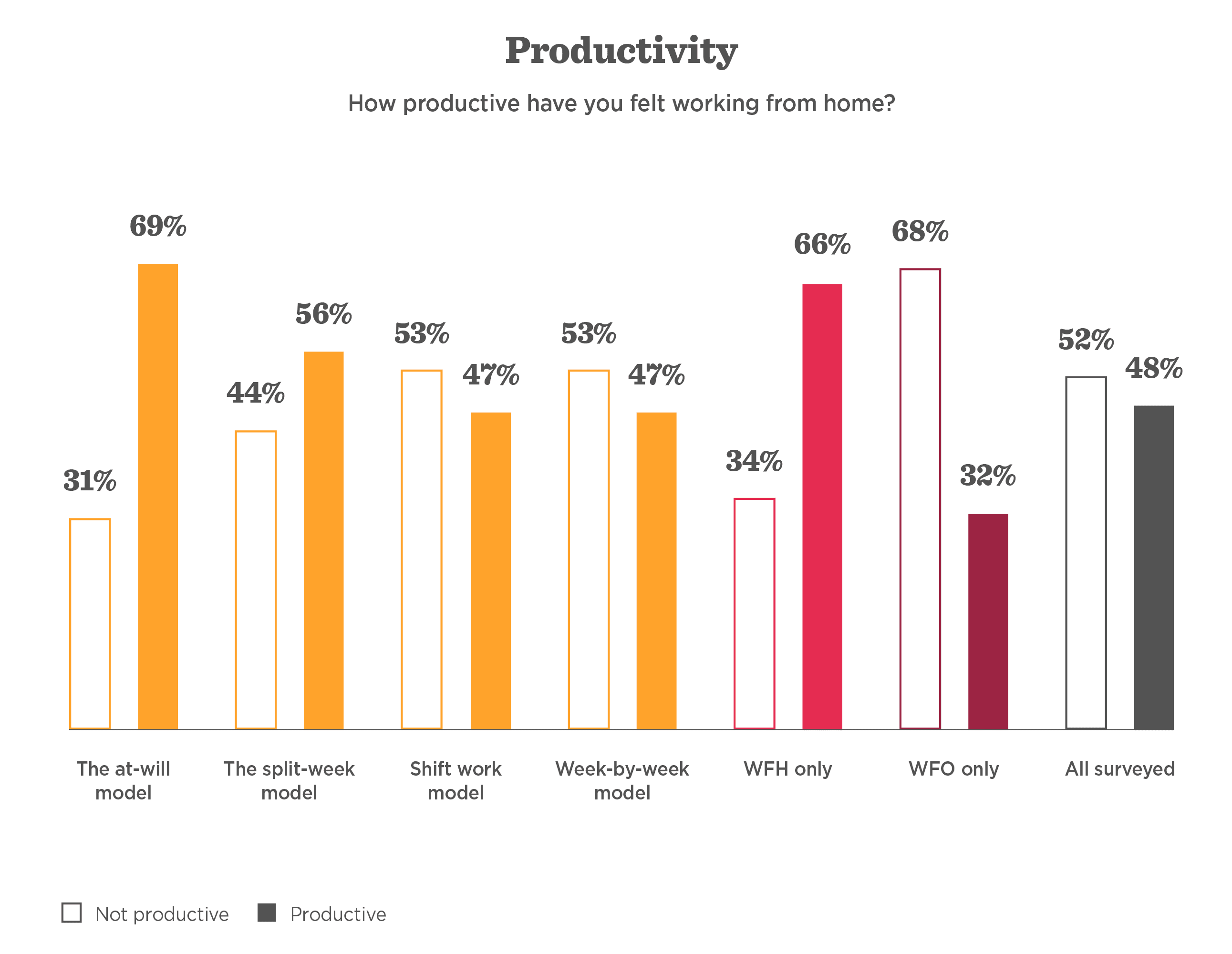
Flexible hybrid options increase job satisfaction
The nature of our work has changed since the pandemic, and so has our job satisfaction. We found that while 53% of survey respondents overall reported being satisfied with their jobs, 47% of employees have not felt satisfied with their jobs since the pandemic began. These results reveal that there is a lot of work to be done to improve job satisfaction during these times—and, according to what we have learned about hybrid work satisfaction, more flexible arrangements could be the solution.
Employees that can work in a hybrid model are more satisfied with their jobs than those working at home exclusively or onsite exclusively. 65% of the employees that could work from home and onsite at-will were satisfied with their jobs, while only 53% of those working onsite exclusively and only 57% of those working from home exclusively were satisfied with their jobs.
HiBob’s conclusion: this high level of satisfaction felt by employees with the at-will policy can be attributed to the sense of freedom that they have regarding where they work. Workplace flexibility is positively associated with increased productivity and job satisfaction.
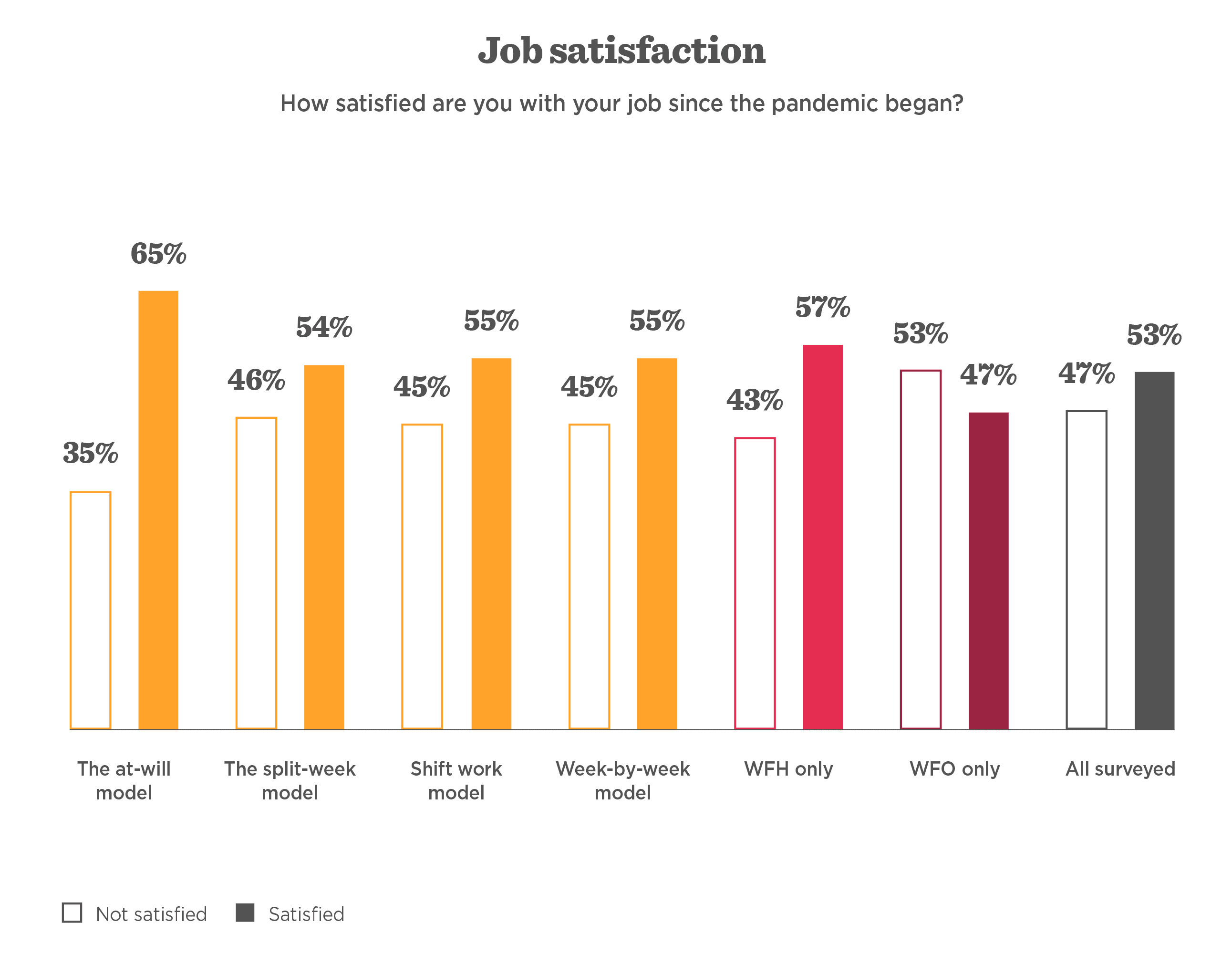
Hybrid work models improve mental health and wellbeing
There’s no doubt that COVID has had a deep impact on mental health worldwide. Isolation, health concerns, and economic uncertainty have together caused a staggering 27% drop in self-reported mental wellness in the workplace across all segments and populations.
When asked about their wellbeing and mental health at work since the pandemic began, our survey revealed that only 48% said that they are doing well. This shows that the overall state of wellbeing at work is not generally positive and people are suffering—especially when compared to pre-pandemic wellbeing levels when only 34% of employees rated their mental health as not good.
Employees look to HR to provide them with a safe working environment and to ensure that they are comfortable and well taken care of at work, especially during these difficult times. Offering flexible workplace solutions is an example of how HR can help employees to remain productive and relieve uncertainty and anxiety.
We found that 60% of employees splitting their week between working at home and working onsite and 54% of employees working from home and onsite at-will reported that they were doing well, while only 50% of employees working exclusively at home and 43% of employees working onsite said that they were doing well.
Hybrid work models have had a positive impact on wellbeing and mental health at work since the pandemic began and HR teams leading this initiative have succeeded in increasing the general wellbeing of their teams.
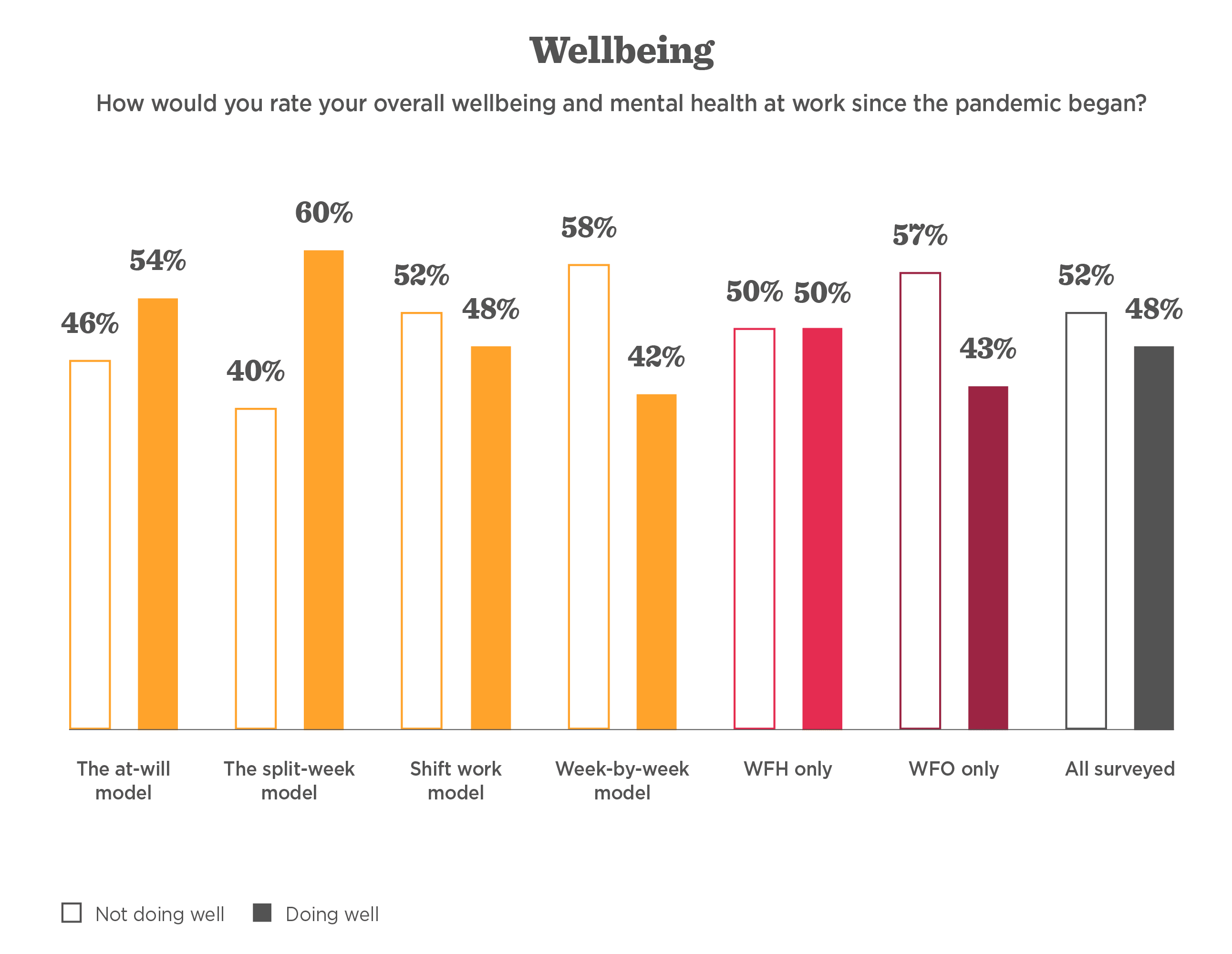
Conclusion
COVID-19 made working from home a necessity overnight, whether we preferred working that way or not. Companies have been tasked with providing flexible solutions for their employees to enable them to continue working safely and effectively while adhering to social distancing and lockdown restrictions.
While there are many working models available, with their relevance depending on the nature of work, we conclude that companies able to offer their employees hybrid models of working, combining working from home and working onsite, are providing the optimal work conditions for their employees in the current climate, and for the foreseeable future. The data from our survey supports this claim.

We found that employees who are working hybrid have a more positive view of their company and HR team, both in terms of their ability to adapt to the pandemic and to specifically address their remote work concerns. They also feel more productive while working at home, which is likely due to a healthy balance between working from home and going into the office. They have higher job satisfaction and report better wellbeing and mental health at work since the pandemic began than employees who are working exclusively from home or onsite.
In these trying times, companies need to adapt to the new reality, but first and foremost, they need to listen to their employees and ensure that their needs and wellbeing are taken care of, to ensure a safe, healthy, and productive future.
